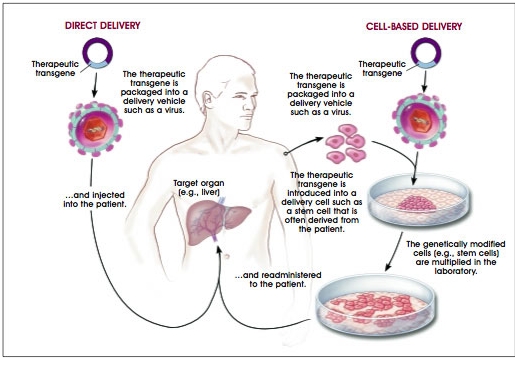Gene therapy techniques are an emerging field of experimental medicine and therapy for treating or preventing hereditary diseases and some infectious diseases. It works by altering the genetic instructions within an individual’s cells or genes by replacing the abnormal genes (responsible for the disease) with normal/healthy genes.
In gene therapy, a gene that is missing or abnormal or is responsible for causing a genetic disorder can be replaced through genetic engineering techniques with a normal and healthy gene so that the medical condition can be addressed.
The medical and general therapeutic effects of gene therapy technologies as it relates to the delivery of desired genes or DNA to the tissues/cells of genetic disease patients may well be a new frontier for the management of other related diseases as well as some other infectious diseases.
Gene therapy may be used to restore the health of a sick patient undergoing particular clinical condition especially genetic diseases since it sees to the delivery of desired genes which are supposed to repair defective genes in the recipient host.
Gene therapy has futuristic benefits and applications particularly in the health system. Gene therapies may be used to prevent, treat, or cure certain inherited (genetic) disorders, such as cystic fibrosis and sickle cell disease that are caused by genetic abnormalities in the body. They also may be used to treat cancers and some infectious and non-infectious diseases such as heart disease, HIV, diabetes and haemophilia.
Thus gene therapy has some specific functions, and these functions are as follows:
- Gene therapy techniques replace defective or missing genes in genetic disorder patients through the delivery of therapeutic DNA or genes.
- The desired therapeutic DNA delivered or inserted into the tissue/cells of the host stimulates the development of new tissues that replaces the defective ones.
- Gene therapy technologies deliver therapeutic genes that destroy cancerous cells and/or tumours in the body of the recipient host.
- Therapeutic DNA inserted into host cells also help to spur the healing process of damaged tissues; and they can also cause cancer cells to regress back to normal cells.
- Of most importance is the fact that gene therapy could be used in the near future to improve the process of immunization/vaccination through the specific and targeted delivery microbial genes (especially those of viruses, bacteria and fungi) that will help to ameliorate some of the infectious diseases of man.
References
Alberts B, Bray D, Johnson A, Lewis J, Raff M, Roberts K and Walter P (1998). Essential Cell Biology: An Introduction to the Molecular Biology of the Cell. Third edition. Garland Publishing Inc., New York.
Dale J (2003). Molecular genetics of bacteria. Jeremy W. Dale and Simon Park (4th eds.). John Wiley & Sons Ltd, West Sussex, UK.
Edelstein, M. L., Abedi, M. R., Wixon, J., and Edelstein, R. M. (2004). Gene therapy clinical trials worldwide 1989-2004—an overview. J Gene Med, 6: 597-602.
Ferrua, F.; Brigida, I.; Aiuti, A. (2010). Update on gene therapy for adenosine deaminase-deficient severe combined immunodeficiency. Current Opinion in Allergy and Clinical Immunology. 10 (6): 551–556.
Gardlík R, Pálffy R, Hodosy J, Lukács J, Turna J, Celec P; Pálffy; Hodosy; Lukács; Turna; Celec (2005). Vectors and delivery systems in gene therapy. Med Sci Monit. 11 (4): RA110–21.
Horn PA, Morris JC, Neff T, Kiem HP; Morris; Neff; Kiem (2004). Stem cell gene transfer—efficacy and safety in large animal studies. Mol. Ther. 10 (3): 417–31.
S Li and L Huang (2000). Nonviral gene therapy: promises and challenges. Gene Therapy, 7:31-34. www.nature.com/gt
Salmons B, Günzburg WH; Günzburg (1993). Targeting of retroviral vectors for gene therapy. Hum Gene Ther. 4 (2): 129–41.
Sambrook, J., Russell, D.W. (2001). Molecular Cloning: a Laboratory Manual, 3rd edn. Cold Spring Harbor Laboratory Press, New York.
Sheridan C (2011). Gene therapy finds its niche. Nature Biotechnology. 29 (2): 121–128.
Tamarin Robert H (2002). Principles of Genetics. Seventh edition. Tata McGraw-Hill Publishing Co Ltd, Delhi.
Twyman R.M (1998). Advanced Molecular Biology: A Concise Reference. Bios Scientific Publishers. Oxford, UK.
Vannucci, L; Lai, M; Chiuppesi, F; Ceccherini-Nelli, L; Pistello, M (2013). Viral vectors: A look back and ahead on gene transfer technology. The new microbiologica. 36 (1): 1–22.
Discover more from Microbiology Class
Subscribe to get the latest posts sent to your email.





